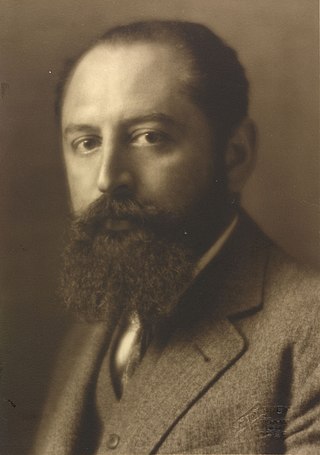Related Research Articles
Kontra-Punkte is a composition for ten instruments by Karlheinz Stockhausen which resolves contrasts among six instrumental timbres, as well as extremes of note values and dynamic levels, into a homogeneous ending texture. Stockhausen described it: "Counter-Points: a series of the most concealed and also the most conspicuous transformations and renewals—with no predictable end. The same thing is never heard twice. Yet there is a distinct feeling of never falling out of an unmistakable construction of the utmost homogeneity. An underlying force that holds things together—related proportions: a structure. Not the same Gestalten in a changing light. But rather this: various Gestalten in the same light, that permeates everything."
In music, instrumentation is the particular combination of musical instruments employed in a composition, and the properties of those instruments individually. Instrumentation is sometimes used as a synonym for orchestration. This juxtaposition of the two terms was first made in 1843 by Hector Berlioz in his Grand traité d'instrumentation et d'orchestration modernes, and various attempts have since been made to differentiate them. Instrumentation is a more general term referring to an orchestrator's, composer's or arranger's selection of instruments in varying combinations, or even a choice made by the performers for a particular performance, as opposed to the narrower sense of orchestration, which is the act of scoring for orchestra a work originally written for a solo instrument or smaller group of instruments.
Luca Lombardi is an Italian composer.

Tierkreis (1974–75) is a musical composition by the German composer Karlheinz Stockhausen. The title is the German word for Zodiac, and the composition consists of twelve melodies, each representing one sign of the zodiac.
Gérard Masson is a French composer.
André Laporte is a Belgian composer.
York Höller is a German composer and professor of composition at the Hochschule für Musik Köln.
In music, a decet—sometimes dectet, decimet, decimette, or even tentet—is a composition that requires ten musicians for a performance, or a musical group that consists of ten people. The corresponding German word is Dezett, the French is dixtuor. Unlike some other musical ensembles such as the string quartet, there is no established or standard set of instruments in a decet.

The trumpet repertoire consists of solo literature and orchestral or, more commonly, band parts written for the trumpet. Tracings its origins to 1500 BC, the trumpet is a musical instrument with the highest register in the brass family.

In Freundschaft is a composition by Karlheinz Stockhausen, number 46 in his catalogue of works. It is a serial composition for a solo instrument, first for clarinet, and later arranged by the composer for many other instruments, often in friendship to specific performers.

Zeitmaße is a chamber-music work for five woodwinds composed in 1955–1956 by German composer Karlheinz Stockhausen; it is Number 5 in the composer's catalog. It is the first of three wind quintets written by Stockhausen, followed by Adieu für Wolfgang Sebastian Meyer (1966) and the Rotary Wind Quintet (1997), but is scored with cor anglais instead of the usual French horn of the standard quintet. Its title refers to the different ways that musical time is treated in the composition.

Punkte (Points) is an orchestral composition by Karlheinz Stockhausen, given the work number ½ in his catalogue of works.
The Dr K–Sextett is a short, occasional composition for six instrumentalists, written in 1969 by Karlheinz Stockhausen and given the number 28 in his catalogue of works.

Alfred August Ulrich Kalmus was an influential Austrian-born British music publisher.

The Modification and Instrumentation of a Famous Hornpipe as a Merry and Altogether Sincere Homage to Uncle Alfred, sometimes shortened to Hornpipe, is an arrangement for six players of Henry Purcell's Hornpipe, from The Fairy-Queen, by Italian composer Luciano Berio. This arrangement was composed in 1969.
Votre Faust : Fantaisie variable genre Opéra is an opera in two acts by the Belgian composer Henri Pousseur, for five actors, four singers, twelve instrumentalists, and tape. The text is by the French author Michel Butor. Originally written between 1960 and 1968, it was premiered on 15 January 1969 at the Piccola Scala in Milan, and revised in 1981. Although about seven hours of performable material exists, the variable structure does not permit use of it all in a single version, and performances to date have been between three and three-and-a-half hours.
References
- ↑ Maconie 2005, 319.
- 1 2 3 Mann 1969a.
- 1 2 3 Mann 1969b.
- ↑ Hopkins and Griffiths 2001.
- ↑ Frisius 2008, 232.
- ↑ Decroupet 2001.
- ↑ Discogs 1976.
Sources
- Decroupet, Pascal. 2001. "Pousseur, Henri". The New Grove Dictionary of Music and Musicians , 2nd edition, edited by Stanley Sadie and John Tyrrell. London: Macmillan.
- A Garland for Dr. K. (1976 LP) at Discogs
- Frisius, Rudolf. 2008. Karlheinz Stockhausen II: Die Werke 1950–1977; Gespräch mit Karlheinz Stockhausen, "Es geht aufwärts". Mainz, London, Berlin, Madrid, New York, Paris, Prague, Tokyo, Toronto: Schott Musik International. ISBN 978-3-7957-0249-6.
- Hopkins, G. W., and Paul Griffiths. 2001. "Boulez, Pierre". The New Grove Dictionary of Music and Musicians, 2nd edition, edited by Stanley Sadie and John Tyrrell. London: Macmillan.
- Maconie, Robin. 2005. Other Planets: The Music of Karlheinz Stockhausen. Lanham, Maryland, Toronto, Oxford: Scarecrow Press. ISBN 0-8108-5356-6.
- Mann, William. 1969a. "A Garland for Dr Kalmus". The Times , issue 57542 (Wednesday, April 23): 16, col D.
- Mann, William. 1969b. "Music in London: Birthday Concerts" [Alfred Kalmus]. The Musical Times 110, no. 1516, 125th anniversary issue (June): 645. doi:10.2307/951793 JSTOR 951793